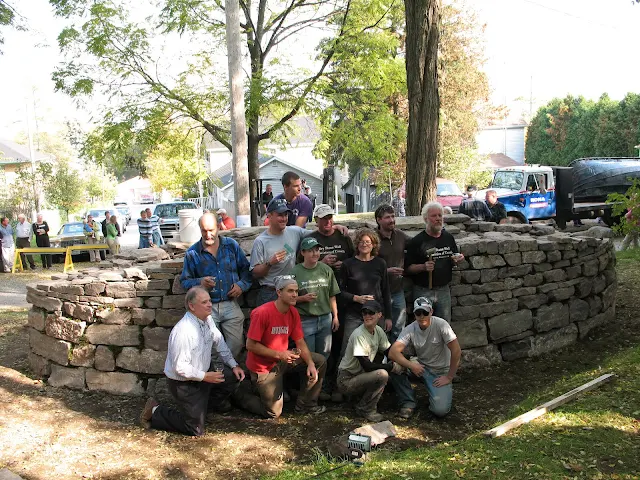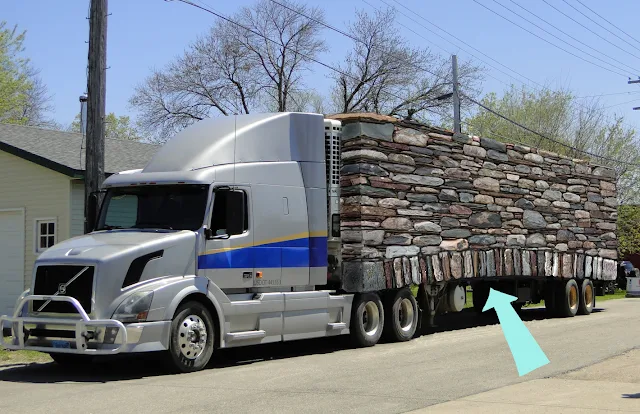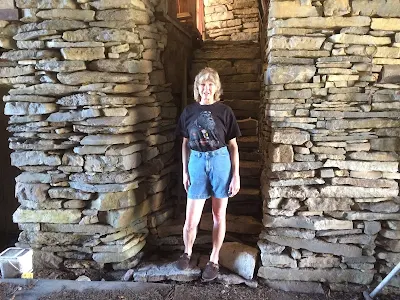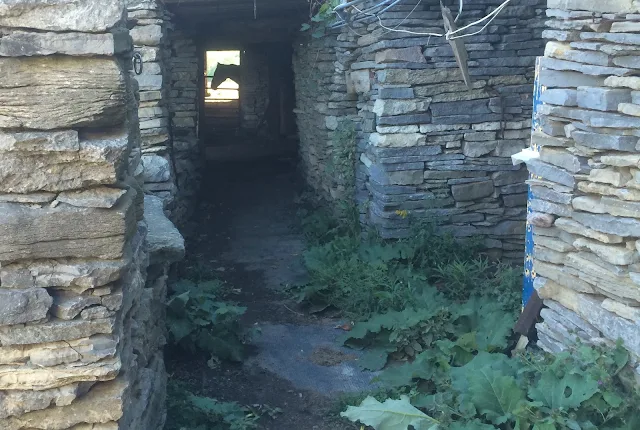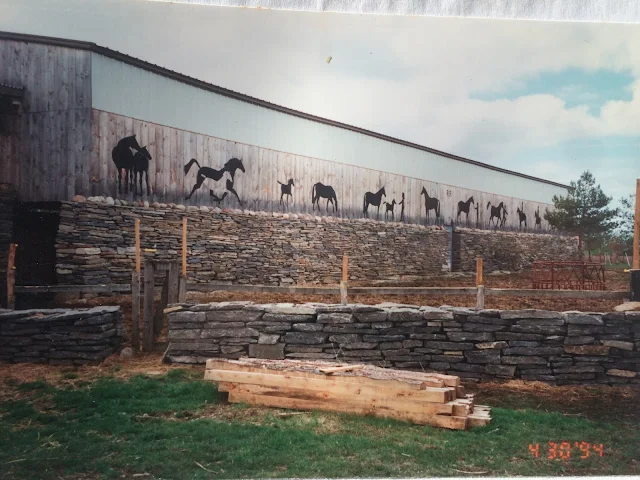Friday, September 30, 2016
Thursday, September 29, 2016
Whatever floats your stone
This is one clever variation of many older types of stone boats The metal blades are dragged to either side of the boulder and then after they are coupled at the front they are scissored together by the pulling action of the horses or tractor. The blades slide under the boulder and then drag it along. No lifting or rolling is required.
Wednesday, September 28, 2016
Two stone boats on two different coasts
Continuing on the theme of stone boats, I assembled this one, a small sailboat installation on the Mowat's lawn sometime ago near St Peter's Nova Scotia. It's made from four stones I found on their beach when we were visiting Farley and Caire in the summer of 2007. The crazy hull-shaped stone was the inspiration and impetus for doing a boat at all. Claire tells me it's still moored up there at their summer place out east.
Here's another boat made of two stones I found laying very close to each other, this time out on the west coast. I balanced them last year on a day off before doing a dry stone workshop out in Victoria BC.
Again finding the stone with a hull shape gave me the idea.
It's not just people, or books, or all that active input we get from all around us or surfing the internet. Sometimes it's just ordinary inactive stones just lying around that give us ideas.
I wonder about stones like these, continuing on one course, which involves mostly a lot of waiting, and then rather strangely, in the eventual unfolding of time, someone comes along and in a kind of destined way, finds them and fits them together in a new shape (it doesn't have to be a boat) and so sets them on a new course. In a way, isn't that exactly what we wallers do every time we fit courses of stones in a wall ?
Tuesday, September 27, 2016
Stones and Boats

This old photo of a stable for ponies on one of the Shetland Islands built from an overturned wooden hull is another example of how boats and stones have been successfully used in combination to create dwelling places in much the same way the pre-Viking people who came to Arctic Canada did over a thousand years ago.

Here is another boat roof/stone foundation combination in France Brittany, Douarnenez Port Rhu, using an old upturned double-ender hull to form a roof for a boat shaped stone cottage
Monday, September 26, 2016
Shadow Balancing
Balancing stones can be very frustrating not to mention time consuming and for some, a bit of an obsession. What's worse, believe it or not, there are those who say that it's criminal to be doing it at all! They hate it. They say it spoils the look of a beach or river bank. It messes with nature and completely ruins all kinds of delicate ecosystems.
So out of deference, I'd like to suggest a low profile, far less environmentally hostile activity. I call it shadow balancing.
You merely arrange 7 stones near each other (lying around the yard preferably) so that at that certain time of the day their shadows create the 'look' of being balanced.
Stones can not be used or taken from anywhere where anything living is still clinging to it, especially in or near streams or where fish spawn or tiny bugs and crayfish reproduce. Stones are never stacked on top of each other creating offensively delicate balancing acts for disapproving dog walkers, ATV enthusiasts (or neighbours, if you do it at home) to object to.
All stones are merely put back after a photo is taken. Passersby and small animals should not be able to notice anything has been rearranged.
It will only be the photo you take of your extemporized stone installation and post on Facebook that will give evidence of your amazing shadow balancing skills.
#Shadowbalancing
Sunday, September 25, 2016
After Imaging
I'm painting rocks and plants again - trying to capture in watercolours Creeping Jenny cascading down the wall.
Painting requires really seeing what your looking at. It's hard and it takes time and concentration. The interesting thing is that when you stop and get up and walk around, for a brief period of time everything appears to be more vivid. There's a sense that the activity of painting and seeing has worked in reverse. You see better because you've painted.
So too, fitting stones together better and better is about learning to see them. Don't just look at them. See them in position. Paint with them. At some point a kind of after image will emerge to help us see of what it is we are looking to build.
Saturday, September 24, 2016
Friday, September 23, 2016
Thursday, September 22, 2016
Modern Farfarers
Whats this? A photo from Oct 2006. These look like very similar rocks to the photo in the previous post. Hmm. Maybe they are still waiting to be made into something.
Ah yes. Here are some of the modern Farfarers who came ten years ago from far and wide to Port Hope to build the original dry stone boat-roofed house. Out of that seemingly useless pile of rocks, this unique monument honouring one of Canada's most prominent authors was constructed.
Watch many of these same Farfarers this coming Canadian Thanksgiving weekend in Port Hope for the celebratory 'relocating' of this structure stone by stone onto public parkland.
Wednesday, September 21, 2016
Double Sided Rocks
After sailing here over a thousand years ago, I imagine the early 'Farfarers, as Farley Mowat called them, would have been terrified of smashing their tiny double-ender boats onto the rocky shores of Ungava Bay in Arctic Canada.
Even after they managed to land safely, though perhaps no longer seen as dangerous, rocks like these would have had no apparent value - that is until they needed to find a way to get through the harsh winter. Then these very same rocks, when piled up carefully in the right shape for fitting their overturned boats onto, would provide the very shelter they needed to survive.
When spring came they would be able to return home in their double-enders now bulging with valuable cargo loads of walrus hides and tusks they had accumulated the year before.
The distinctive boat-shaped stone walls they left behind still remain to this day as documented archaeological sites, and too, as reminders.
That which we try to avoid, or at best, consider useless, can sometimes be the very thing that save us.
Visit www.followingfarley.com
Tuesday, September 20, 2016
Ordered Randomness

Stones, all stones, are either arranged in some sort of pattern, or they are not. They are either made into something by some intelligent being or they are not. There is no in between.
Walls, paths, buildings, bridges, monuments, fireplaces, tombs, standing stones, even balanced stones, have all had some sort of 'thinking hands' on them forming them into a recognizably ordered state, no matter how indecipherable their purpose or meaning.
But are we missing something? Is it possible the different shaped stones all around this long flat rectangular stone found lying on the beach near Caithness are as 'ordered' as the similar shaped stones placed parallel to each other on top of it?
Sunday, September 18, 2016
Does not contain peanuts
If a beer company can claim its product is ' MADE FROM CANADA', why can't we?
Our walls and bridges are made of the stuff of Canada !
- from REAL Canadian rocks!
- from a totally natural resource found locally all across Canada.
- from only pure Canadian geological content. NOT made with or containing any imported manufactured products, including cement !
Saturday, September 17, 2016
Low bridge ahead.
I don't know about you, but when I come along side a big transport flatbed truck on the highway I just love seeing that sexy convex curve that's engineered into the bed of the trailer. I keep wanting to shape 53 feet of voussoirs and then fit them over that arched shape and dry lay tons of stones over that. Then I'd shove huge abutment stones up against the sides of both ends and carefully remove the trailer bed. Voila, instant, very flat segmented arch bridge !
Friday, September 16, 2016
Fond memories of Inis Oirr

One of the best festivals in the dry stone circuit , Feile na gCloc, is held on Inis Oirr Ireland every year and it's on now from the 15th to the 18th of September 2016. I wish I was back there now with so many good walling friends from Canada, the States and across the sea.
I have a lot of fond memories too from the first time I was there on the tour of walls organized by Margot Miller.
Besides ALL the wonderful Irish style dry stacked walls, which are just astonishing in variety and number, there were so many other things too that just blew me away.

For one, I remember being amazed at the size of Irish fuchsi, growing wild the size of small trees. Much much bigger than any we see in the little pots we buy at the garden centres here in Canada.

Another plant that I remember remarking about to Patrick McAfee was the English Ivy. It is everywhere!
Maybe because of the picturesque associations of ivy and walls in Britain and Ireland, we often like to see it planted along the new dry stone walls we build here in Canada .
In Ireland however it is a different case. While in places it can still look attractive, it is nevertheless very invasive.
On the island of Inis Oirr the walls are literally being swallowed up by the ivy. It's not such a pretty site. Patrick surmised that in less than ten years most of these lovely walls will not only be lost to view, they will be destroyed.

Unless something drastic is done, there will be no more magical vistas of dry stone walls in every direction anymore for visitors to marvel at - just a jungle of ivy.
Thursday, September 15, 2016
A little known dry stone treasure.
After being told about it by a passerby at the Clayton Workshop I taught last weekend, Brian, Tom and I took the opportunity to visit an unusual property which had an impressively large horse barn, with ten stalls and a riding arena, all of which were built by one man all and completely dry stone construction !
Marjy, who lives in an historic stone farm house on the property near Clayton N. Y. greeted us and after we explained our connection with dry stone walling kindly showed us around the impressive stone structures built by her late husband Richard Chamberlin . Here she is standing on the stone stairs her husband built to the viewing area over the tack room.
The stone stalls had pillars and walls separating them nearly four feet thick
Apparently all the stones Richard used to build the barn (thousands of tons) were collected mostly from the Chamberlin's property and the rest was gathered (perhaps from an older fallen down barn) about a mile away.
The riding arena attached to the horse barn also had dry stone walls on all sides.
Detail of how rings for hitching horses were incorporated into the walls.
Five of the stalls led directly to the outside loafing area.
Marjy showed us a photo of how the dry stone arena looked in 1994
For many of the walls Richard used the hay elevator for carrying each individual stone up.
She explained that Richard also built up stone columns in temporarily ascending heights and then with planks on them walked up with wheelbarrow loads of stone to facilitate building the higher walls and gables.
I asked to see a better photo of the man who accomplished such an amazing amount of stone work and Marjy found this photo of Richard who is seen here with his son not long after the barn was completed in 1992 . He started it in1990
Parts of the barn are still in very good condition while other sections have begun to lean and deteriorate
Wednesday, September 14, 2016
Whatever rings your bell
These guys know how to enjoy their ten days at the cottage. Brian and Tom built a dry stone bell tower last week on the concrete pad where the old family flagpole used to be. It's ten feet tall (with the bell) and it's beautifully constructed from weathered stones from their beach.
The four by four post was bolted into the same angle irons that held the flag pole. On top of it a square of plywood was secured and so fixing the top four corners for the string lines to mark ample 'batter' lines for the sturdy bell tower structure to be built to.
I can't think of anything more handsome (or useful) for announcing to fellow cottagers that it's Happy Hour.
Tuesday, September 13, 2016
Cheers
Big thanks to our bench walling team last weekend.
Jim Rebecca Mike Tom Luke Trudde Jane Margie Day and Brian.
This workshop was another successful collaborative effort organized by the Thousand Islands Arts Center (TIAC) and the Thousand Islands Land Trust (TILT), both Clayton N Y non-profit organizations.
Special thanks to Fred Bach of Bach&Co for supplying the very attractive and very workable blue stone material
A detail of the bench the angled stones running along the back of the bench intersected with the stones forming the front of the bench angled in the opposite direction .
What a pleasure it was too having these two talented guys helping me again this year. Brian Mulcahy and Tom Dolan.
Tomorrow I'll post photos of their newest dry stone project.
Monday, September 12, 2016
Saturday, September 10, 2016
Not yet made in the shade
We're in Clayton N Y this weekend. Ah, here's a nice cool place out of the sun. Let's build something to sit on using local dry laid limestone material.
Perhaps this bench design we came up with would be just the thing ?
Wall ends built into the ground so there's no worry about the end copes getting knocked off. Contrasting angles of diagonal builders below and above seat stones. Fairly pleasing look. Hmm. Okay. Let's see how we do!
Friday, September 9, 2016
Wonder
How can we create beauty without a sense of wonder ? How could anyone think of dry stone walling as just a job? How could someone only come to the craft merely as a platform for competition and just a way of getting ahead. And yet I worked with a man who used to think that way for years
As much as I tried to encourage him he refused to approach walling as an art, to pause and ponder the magic, the wonder of it.
He told me that being looked up to by other wallers was all he wanted from walling, all that he looked to accomplish through striving with dry stone, and hopefully, to eventually become the best known waller in the country.
I have to respect that. I also have to sigh.
I think the art and joy and spontaneity and yes the wonder of working with stone can sometimes be lost when we take ourselves, and what others think of us, too seriously. There is a magical potential waiting in every stone we pick up to forget all that. Stones will always invite us to just wonder, and basically, to lighten up.
Subscribe to:
Comments (Atom)











